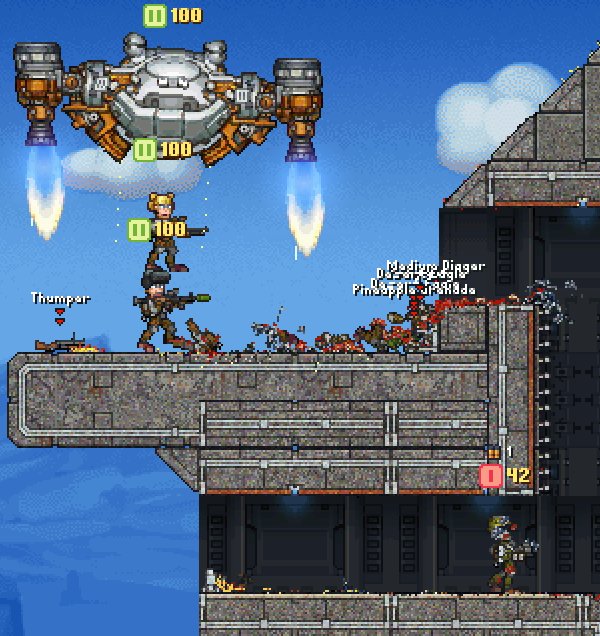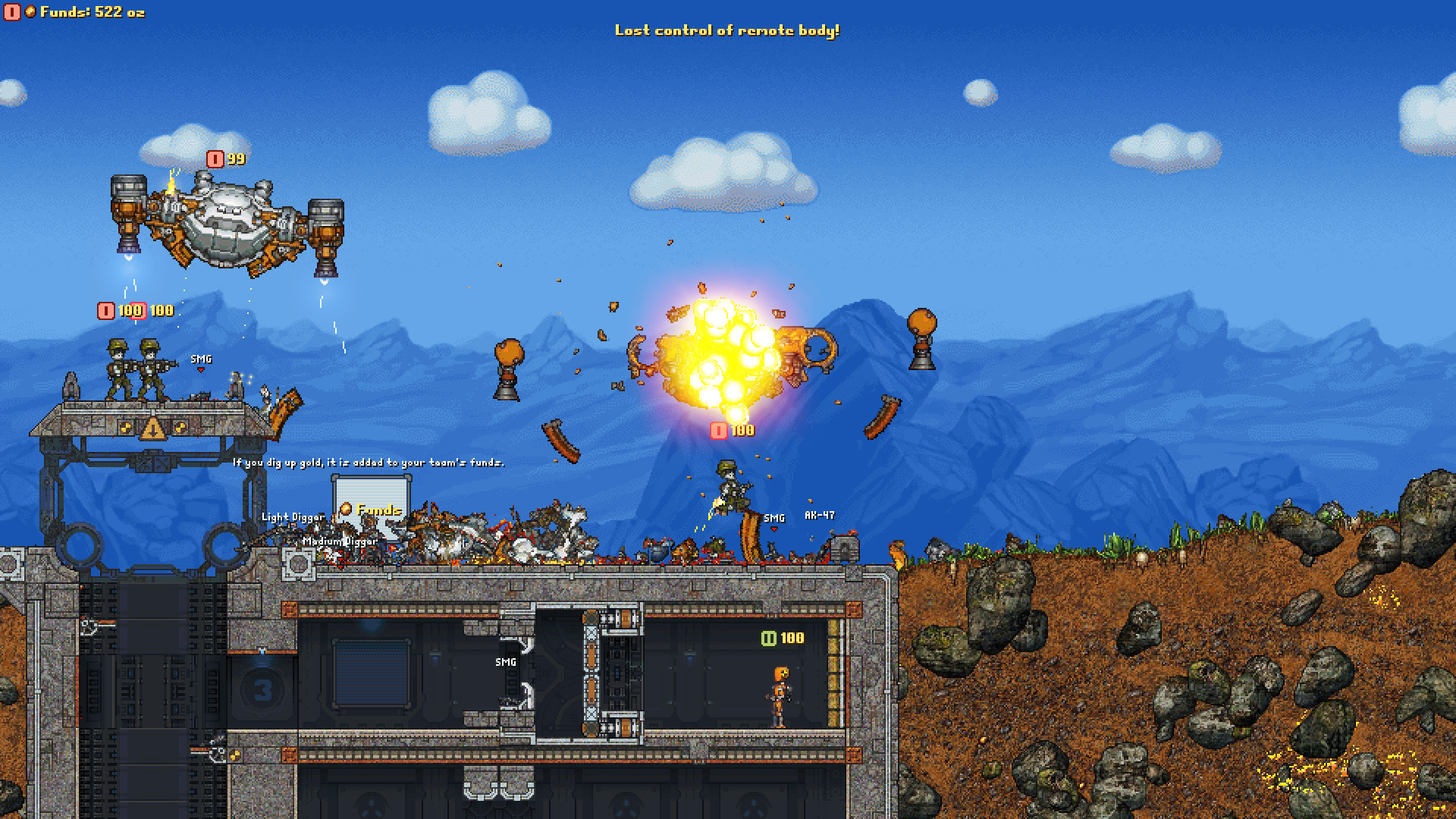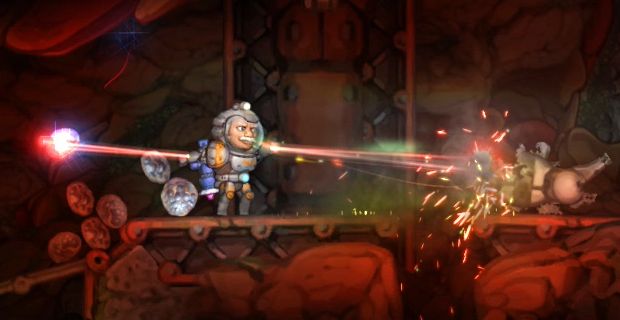Wot I Think: Cortex Command
Jetpacked with gratuitous violence
Robot-building, base-constructing, side-scrolling, brain-protecting, physics-physicking slapstick tactical combat game Cortex Command finally has a campaign version and so is, in a sense, finished. It's also out on Steam. Tim sent his own brain in to investigate.
On reaching the lip of the service shaft, combat robot no. J89/7007 pauses and looks down. 50ft below, glittering in the gloom, are the bullet-shredded remains of combat robots J89/6998 to J89/7006. The automaton thinks about vomiting, then, remembering his lack of digestive system and fear circuits, opts to walk forward instead. By the time he lands with a jetpack-retarded crunch in the midst of the junk pile, his minigun is spinning at maximum revs.

The next six seconds are utterly devoid of love, compassion, or mercy. The first to perish is a crippled MG drone in the mouth of the right-hand tunnel. Next a Coalition sniper crouched behind a concrete block on the left, gets his skull-top sliced clean off by the intruder's whirring bunker broom. The bot is busy reloading when a red-hot blast of Mauler shrapnel from another cover-hugging Coalitionist tears the minigun from his alloy fingers and traumatically amputates his left leg.
Smoke and bouncing sparks dissipate to reveal the now monopedal J89/7007 hopping valiantly towards his mutilator. On arrival the homicidal pogo stick uses his mining tool to turn his target into a cloud of crimson man-mince. Falling flesh chunks splutch onto the debris-littered corridor floor while, in the far distance a defeat-facing gamer can be heard emitting a sound that's half wail of anguish, half gasp of awed amazement.
Wave a soggy wrist stump at Cortex Command. Assuming you're one of the eight RPS readers that don't already own this £14 tactics test-tube, be aware that every session is studded with dozens of wincingly brutal combat moments similar to the one just described. A vast arsenal of weapons combined with a fabulously physical physics system, guarantee you some of the most gripping and grisly RTS warfare this side of Men of War.
I often find myself thinking of MoW while playing Cortex. Though Team 17's wiggly signature series is the more obvious touchstone, the bone-crunching destruction has a tactile, unpredictable quality to it that devotees of Direct Control are sure to recognise and relish.
When it comes to combat subtleties and realism, Cortex might actually have the edge over its Best Way compadre. In addition to the aforementioned gore and dismemberment, this is a game that encourages fox- and mouse-holing, and lets you snipe through the narrowest of self-hewn loopholes. A Battle of Stalingrad or Battle of Ortona title using an adapted form of this engine could be goshing incredible.
Of course, any WW2 spin-off would have to dispense with the gold mining. In most Cortex missions, in addition to orchestrating combat you're also watching over troglodytic gold gleaners. Because dropship-delivered reinforcements are purchased with the game's only resource, and that resource is buried below the surface of battlefields, if you don't assign a portion of your force to subterranean scouring then you eventually run out of the cash necessary to sustain assaults or replenish defences.
The other key concept shaping slaughter sessions is brain preservation. Usually victory is achieved by locating and eliminating an enemy faction's force-coordinating brain-unit. This could be a static organ sitting in a jar in a reinforced vault at the heart of an enemy bunker system, or a mobile brain-robot busy assisting its own war effort through mining. Unless you're defending a domestic bunker, the opening phase of any scrap generally begins with some frantic defence preparation. While a cordon of turrets and troops is airlifted in, you rush to get your fragile perambulating cerebrum into a newly excavated tunnel network or defensible cave. Mismanage this crucial stage and you can easily find yourself looking on helplessly as terrier-like foes scramble through the mouth of a refuge-turned-rat-trap.
And “scramble through” isn't wishful thinking in this instance. The mix of QWOP-style soldier skeletons (though, happily, directly controlled units are moved with WASD keys) and endlessly deformable battlefields means every scenery pixel matters when it come to pathfinding and Line of Fire calculations. Troops slither, squeeze and tumble through catacombs. They widen home-made portals with mining tools or attempt to seal them off with concrete sprayers. Bullets nibble at trench edges and chip away at bunker walls. The options for using and abusing the environments are mind-boggling.
Hence, it shouldn't come as too much of a surprise to hear that AI-controlled forces can struggle to compete against us wily humans. While difficulty settings and single scenario victory conditions guarantee challenge, there will be times - especially when you've got a few days of battle experience under your belt - when you find yourself sitting back and giggling while the CPU either shoots itself repeatedly in the feet, or dithers suicidally while you scheme. Certain base designs (in the campaign, you're free to design your own fortresses) can baffle artificial assaulters. Certain weapons and tools, it ignores or uses with splashtastically fatal results. Where possible I always recon-by-fire and advance with a medbot scuttling just behind my scout. The AI, unless scripted to do so, never exhibits this kind of canniness.
Cortex has other flaws too. It might be years since its demo first turned heads, but devs Data Realms still haven't managed to eliminate all slow-down and crash bugs. The biggest disappointment in my book, is that they've also yet to find a really compelling and coherent way of contextualising those savage, surprise-strewn firefights.
This is how campaigns currently work: A selection of up to four factions fight over a planet's lucrative mining sites. From an overview map accessed before battles, you select which sites you're going to contest, and which bases you'd like to improve. The more sites you wind-up controlling, the more income you have available to finance assaults and home improvements. Once a player's limited supplies of brains have been used-up, that player is out of the running.
It sounds fine on paper, and, most of the time, works reasonably well in practice. What it lacks is tonal variety... interesting supplementary activities... characters... a sense of import. It feels like a barebones mechanism for delivering skirmishes rather than a doorway into Cortex's incredibly rich armoury or enigmatic lore.
I've been publicly pillorying the deliverers of linear RTS scenario sequences for more than a decade, yet in the case of Cortex find myself wishing the campaign was a little more conventional and story-heavy. In a game as splendidly provisioned with weaponry, tools, and building materials as this one, it's a travesty that everything is instantly available at the start of the campaign. Perhaps if we'd been forced to scrape by with bog-standard SMGs , pistols, and shotguns for an outing or two, then more exotic kit, when introduced, might have felt special. Slowly researching or scavenging/reverse-engineering new tech might have helped reduce bewilderment too. The present tutorial leaves large swathes of the game unexplained.
There's so much wonderful chaos, so many alluring tactical options, within Cortex's combat, I'm not sure the game needs the AI-straining freedoms of a sandbox campaign. A set of skrmish modes plus a skilfully wrought mission sequence spiced with bespoke tech tree clambering, would have made Cortex a far more rounded and approachable creature. As it is, you're almost certain to fall for its charms faster than a combat robot corpse tumbling down a bunker shaft (especially if you've got a pal/spouse/sibling ready and willing for split-screen action) but you may end up wishing it was a little less free with its hardware, and a tad more traditional in its campaign attitude.













